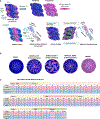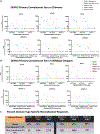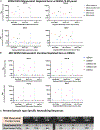Homotypic antibodies target novel E glycoprotein domains after natural DENV 3 infection/vaccination
- PMID: 37909048
- PMCID: PMC11221912
- DOI: 10.1016/j.chom.2023.10.004
Homotypic antibodies target novel E glycoprotein domains after natural DENV 3 infection/vaccination
Abstract
The envelope (E) glycoprotein is the primary target of type-specific (TS) neutralizing antibodies (nAbs) after infection with any of the four distinct dengue virus serotypes (DENV1-4). nAbs can be elicited to distinct structural E domains (EDs) I, II, or III. However, the relative contribution of these domain-specific antibodies is unclear. To identify the primary DENV3 nAb targets in sera after natural infection or vaccination, chimeric DENV1 recombinant encoding DENV3 EDI, EDII, or EDIII were generated. DENV3 EDII is the principal target of TS polyclonal nAb responses and encodes two or more neutralizing epitopes. In contrast, some were individuals vaccinated with a DENV3 monovalent vaccine-elicited serum TS nAbs targeting each ED in a subject-dependent fashion, with an emphasis on EDI and EDIII. Vaccine responses were also sensitive to DENV3 genotypic variation. This DENV1/3 panel allows the measurement of serum ED TS nAbs, revealing differences in TS nAb immunity after natural infection or vaccination.
Keywords: RNA; antibody; dengue virus; immunity; monoclonal; natural infection; polyclonal; sera; structural targets; vaccine.
Copyright © 2023 Elsevier Inc. All rights reserved.
Conflict of interest statement
Declaration of interests R.S.B. and E.H. have served on the Scientific Advisory Boards for Takeda vaccines, VaxArt, and Invivyd Therapeutics and has collaborations with Gilead, Janssen Pharmaceuticals, Pardas Biosciences, and Chimerix. A.M.D. has served as an unpaid consultant for Moderna and Takeda vaccines and is an unpaid member of Merck’s dengue vaccine Scientific Advisory Board, and R.S.B. and A.M.D. are inventors on pending and approved flavivirus vaccine and diagnostic patents filed by the University of North Carolina at Chapel Hill. A.M.D. is co-directing a partnership program between UNC and Moderna to develop flavivirus vaccines. UNC has applied for a patent related to the chimeric viruses. J.E.C. has served as a consultant for Takeda vaccines, Sanofi Pasteur, Pfizer, and Novavax; is on the Scientific Advisory Boards of CompuVax and Meissa Vaccines; and is a Founder of IDBiologics, Inc.
Figures







References
-
- de Silva AM, and Harris E. (2018). Which dengue vaccine approach is the most promising, and should we be concerned about enhanced disease after vaccination? The path to a dengue vaccine: learning from human natural dengue infection studies and vaccine trials. Cold Spring Harb. Perspect. Biol. 10, a029371. 10.1101/cshperspect.a029371. - DOI - PMC - PubMed
-
- CDC (2021). About dengue. https://www.cdc.gov/dengue/about/index.html.
MeSH terms
Substances
Grants and funding
LinkOut - more resources
Full Text Sources
Medical

